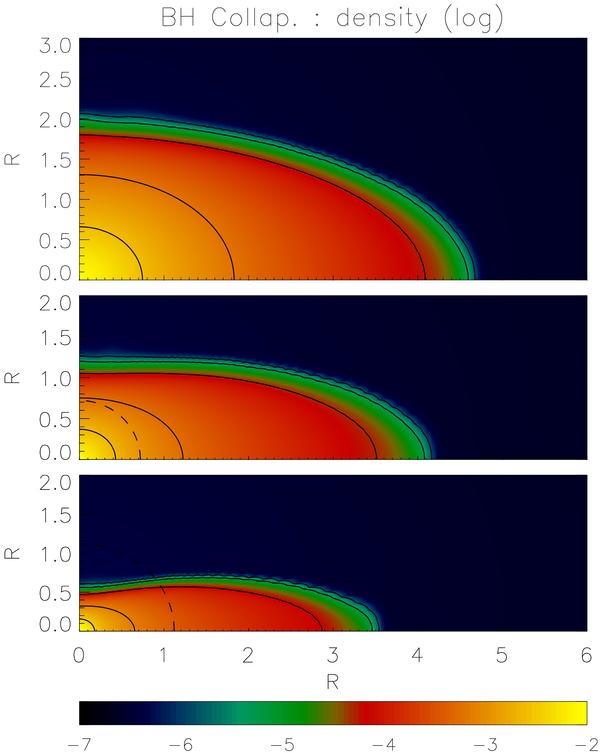GRMHD

Most of the astrophysical sources of high-energy radiation and particles are believed to involve the presence of relativistic motions in magnetized plasmas. For example, the radio emission from extra galactic jets (especially from terminal radio lobes) or from plerionic supernova remnants (e.g. the Crab Nebula) is due to synchrotron radiation produced by relativistic electrons spiraling around magnetic field lines, thus indicating the presence of significant magnetic fields.
Strong magnetic fields are supposed to play an essential role in
converting the energy of accreting material around super-massive
black holes at the center of Active Galactic Nuclei (AGNs), into
powerful relativistic jets escaping along open field lines. Similar
phenomena may be at work in the galactic compact X-ray sources known
as microquasars and even in Gamma Ray Burst (GRB) engines. These
processes involve highly nonlinear interactions of relativistic
gasdynamic flows and shocks with gravitational and magnetic
fields. The fluid approximations employed to study the dynamics of
relativistic plasmas are special relativistic MHD (SRMHD) and
general relativistic MHD (GRMHD), the latter in the case when the
curvature of space-time becomes significant in the vicinity of a
compact object.
A strong impulse to the study of these complex phenomena has come from
numerical simulations, especially in the last decade. Since
relativistic magnetized flows are often associated with the
formation of strong shocks and different kinds of discontinuities,
it is thanks to the development of conservative shock-capturing, or
Godunov-type, methods that this progress has been possible. After
the first applications to special and general relativistic
hydrodynamics, Komissarov (1999) first proposed a multi-dimensional
shock-capturing code for SRMHD based on the so-called Roe-type
methods, widely used in computational gas dynamics, in which the

solution of the local Riemann problem at any cell interface is
constructed by means of a full decomposition into characteristic waves
(note that the SRMHD eigen-structure is not solvable analytically,
contrary to classical MHD).
Accurate and robust Riemann solvers for
SRMHD requiring fewer eigen-modes have been also recently
developed. Relying on the promising results obtained for classical MHD
members of our group first proposed a different approach for SRMHD:
one or two-wave Riemann solvers are used component-wise in combination
to higher-order spatial upwind reconstruction (third order at
least). This latter scheme has also been extended to GRMHD, and to the
case of an evolving spacetime metric. Most of the codes available
nowadays for SRMHD and GRMHD make use of a simplified Riemann solver.
The numerical code developed and used by our group has been named ECHO
(Eulerian Conservative High Order code), it is written in Fortran90
using a modular approach, and solves the set of hyperbolic
conservative equations in the so-called 3+1 formalism, in which space
and time are clearly disentangled. For evolving spacetimes, Einstein
equations are solved in axisymmetric configurations under the
Conformally Flat Condition (CFC), appropriate for studying isolated
neutron stars and black holes. Initial conditions for magnetized
neutron stars are provided by the publicly available
XNS code
 solution of the local Riemann problem at any cell interface is
constructed by means of a full decomposition into characteristic waves
(note that the SRMHD eigen-structure is not solvable analytically,
contrary to classical MHD).
Accurate and robust Riemann solvers for
SRMHD requiring fewer eigen-modes have been also recently
developed. Relying on the promising results obtained for classical MHD
members of our group first proposed a different approach for SRMHD:
one or two-wave Riemann solvers are used component-wise in combination
to higher-order spatial upwind reconstruction (third order at
least). This latter scheme has also been extended to GRMHD, and to the
case of an evolving spacetime metric. Most of the codes available
nowadays for SRMHD and GRMHD make use of a simplified Riemann solver.
The numerical code developed and used by our group has been named ECHO
(Eulerian Conservative High Order code), it is written in Fortran90
using a modular approach, and solves the set of hyperbolic
conservative equations in the so-called 3+1 formalism, in which space
and time are clearly disentangled. For evolving spacetimes, Einstein
equations are solved in axisymmetric configurations under the
Conformally Flat Condition (CFC), appropriate for studying isolated
neutron stars and black holes. Initial conditions for magnetized
neutron stars are provided by the publicly available XNS code
solution of the local Riemann problem at any cell interface is
constructed by means of a full decomposition into characteristic waves
(note that the SRMHD eigen-structure is not solvable analytically,
contrary to classical MHD).
Accurate and robust Riemann solvers for
SRMHD requiring fewer eigen-modes have been also recently
developed. Relying on the promising results obtained for classical MHD
members of our group first proposed a different approach for SRMHD:
one or two-wave Riemann solvers are used component-wise in combination
to higher-order spatial upwind reconstruction (third order at
least). This latter scheme has also been extended to GRMHD, and to the
case of an evolving spacetime metric. Most of the codes available
nowadays for SRMHD and GRMHD make use of a simplified Riemann solver.
The numerical code developed and used by our group has been named ECHO
(Eulerian Conservative High Order code), it is written in Fortran90
using a modular approach, and solves the set of hyperbolic
conservative equations in the so-called 3+1 formalism, in which space
and time are clearly disentangled. For evolving spacetimes, Einstein
equations are solved in axisymmetric configurations under the
Conformally Flat Condition (CFC), appropriate for studying isolated
neutron stars and black holes. Initial conditions for magnetized
neutron stars are provided by the publicly available XNS code

 Arcetri High Energy Group
Arcetri High Energy Group 